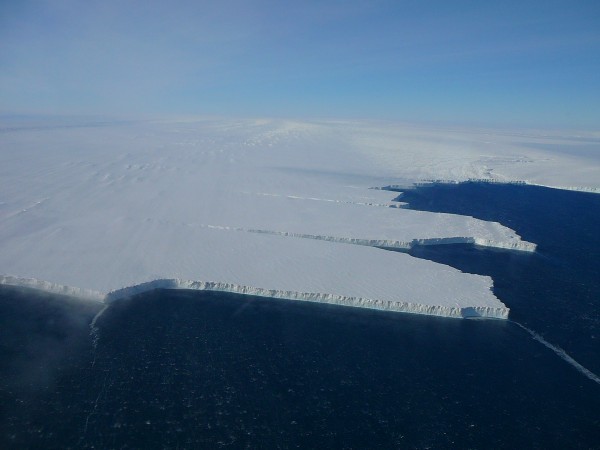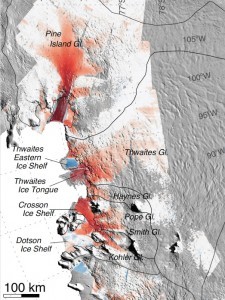Clock Is Ticking in West Antarctic
“The high-resolution records that we’re getting and the high-resolution models we’re able to make now are sort of moving the questions a little bit closer into human, understandable time frames.”

Reports that a portion of the West Antarctic Ice Sheet has begun to irretrievably collapse, threatening a 4-foot rise in sea levels over the next couple of centuries, surged through the news media last week. But many are asking if even this dramatic news will alter the policy conversation over what to do about climate change.
Glaciers like the ones that were the focus of two new studies move at, well, a glacial pace. Researchers are used to contemplating changes that happen over many thousands of years.
This time, however, we’re talking hundreds of years, perhaps — something that can be understood in comparison to recent history, a timescale of several human generations. In that time, the papers’ authors suggest, melting ice could raise sea levels enough to inundate or at least threaten the shorelines where tens of millions of people live.
“The high-resolution records that we’re getting and the high-resolution models we’re able to make now are sort of moving the questions a little bit closer into human, understandable time frames,” said Kirsty Tinto, a researcher from Lamont-Doherty Earth Observatory who has spent a decade studying the Antarctic.
“We’re still not saying things are going to happen this year or next year. But it’s easier to grasp [a couple of hundred years] than the time scales we’re used to looking at.”
The authors of two papers published last week looked at a set of glaciers that slide down into the Amundsen Sea from a huge ice sheet in West Antarctica, which researchers for years have suspected may be nearing an “unstable” state that would lead to its collapse. The West Antarctic Ice Sheet is mostly grounded on land that is below sea level (the much larger ice sheet covering East Antarctica sits mostly on land above sea level).
Advances in radar and other scanning technologies have allowed researchers to build a detailed picture of the topography underlying these glaciers, and to better understand the dynamics of how the ice behaves. Where the forward, bottom edge of the ice meets the land is called the grounding line. Friction between the ice and the land holds back the glacier, slowing its progress to the ocean. Beyond that line, however, the ice floats on the sea surface, where it is exposed to warmer ocean water that melts and thins these shelves of ice. As the ice shelves thin and lose mass, they have less ability to hold back the glacier.
What researchers are finding now is that some of these enormous glaciers have become unhinged from the land – ice has melted back from earlier grounding lines and into deeper basins, losing its anchor on the bottom, exposing more ice to the warmer ocean water and accelerating the melting.
In their paper published in Geophysical Research Letters, Eric Rignot and colleagues from the University of California, Irvine, and NASA’s Jet Propulsion Laboratory in Pasadena, Calif., described the “rapid retreat” of several major glaciers over the past two decades, including the Pine Island, Thwaites, Haynes, Smith and Kohler glaciers.
“We find no major bed obstacle upstream of the 2011 grounding lines that would prevent further retreat of the grounding lines farther south,” they write. “We conclude that this sector of West Antarctica is undergoing a marine ice sheet instability that will significantly contribute to sea level rise in decades to come.”
The region studied holds enough ice to raise sea levels by about 4 feet (Pine Island Glacier alone covers about 62,000 square miles, larger than Florida). If the whole West Antarctic Ice Sheet were to melt, it could raise the oceans about 16 feet.

In the second paper, Ian Joughlin and colleagues from the University of Washington used models to investigate whether the Thwaites and Haynes glaciers, which together are a major contributor to sea level change, were indeed on their way to collapsing. “The simulations indicate that early-stage collapse has begun,” they said. How long that would take varies with different simulations – from 200 to 900 years.
“All of our simulations show it will retreat at less than a millimeter of sea level rise per year for a couple of hundred years, and then, boom, it just starts to really go,” Joughin said in a news release from the University of Washington.
Many scientists who’ve been studying the region were already braced for the storm.
“It’s gone over the tipping point, and there’s no coming back,” said Jim Cochran, another Lamont researcher with experience in the Antarctic. “This … confirms what we’ve been thinking for quite a while.”
Cochran is principal lead investigator for Columbia University in Ice Bridge, the NASA-directed program that sends scientists to Antarctica and Greenland to study ice sheets, ice shelves and sea ice using airborne surveys. Much of the data used in the new papers came from the Ice Bridge project.
Tinto, also an Ice Bridge veteran, agreed. “I thought it was pretty exciting, because we’ve all been working on this area for a long time, and that potential for the West Antarctic Ice Sheet to behave in this way, we’ve been aware of it for a long time,” she said. “[It] made me want to get in there and look at the rest of the area, what else is going on.”
And there are still many questions about what’s going on: How fast the ocean that swirls around Antarctica is warming, how those ocean currents shift, and to what extent that is influenced by global warming.
“I have a problem with the widespread implication (in the popular press) that the West Antarctic collapse can be attributed to anthropogenic climate change,” said Mike Wolovik, a graduate researcher at Lamont-Doherty who studies ice sheet dynamics. “The marine ice sheet instability is an inherent part of ice sheet dynamics that doesn’t require any human forcing to operate. When the papers say that collapse is underway, and likely to last for several hundred years, that’s a reasonable and plausible conclusion.”
But, he said, the link between CO2 levels and the loss of ice in West Antarctica “is pretty tenuous.” The upwelling of warmer waters that melt the ice has been tied to stronger westerly winds around Antarctica, which have been linked to a stronger air pressure difference between the polar latitudes and the mid-latitudes, which have in turn been linked to global warming.
“I’m not an atmospheric scientist, so I can’t evaluate the strength of all of those linkages,” Wolovik said. “However, it’s a lot of linkages.” And that leaves a lot of room for uncertainty about what’s actually causing the collapse of the glaciers, he said.
Researchers have been discussing the theory of how marine ice sheets become unstable for many years, said Stan Jacobs, an oceanographer at Lamont-Doherty who has studied ocean currents and their impact on ice shelves for several decades.
“Some of us are a bit wary of indications that substantial new ground has been broken” by the two new papers, Jacobs said. While ocean temperatures seem to be the main cause of the West Antarctic ice retreat, there’s a lot of variability in how heat is transported around the ocean in the region, and it’s unclear what’s driving that, he said. And, he’s skeptical that modeling the system at this point can accurately predict the timing of the ice’s retreat.
But, he added, “this is one more message indicating that a substantial sea level rise from continued melting of the West Antarctic Ice Sheet could occur in the foreseeable future. In the absence of serious near-term greenhouse gas mitigation efforts, such as an escalating tax on carbon, they may well be right.”
“It starts bringing it a little closer to home,” said Tinto. “It’s a significant amount of change, but something we can start planning for. Hopefully [this will] make people stop procrastinating and start planning for it.”
Cochran agreed: The papers’ message is “that … over the next couple hundred years, there’s going to be a significant rise in sea level, and at this point we can’t stop it.” But, he added, “it doesn’t say give up on trying to cut emissions. … [Just] don’t buy land in Florida.”
____________________________________________
For further details on what’s going on in West Antarctica, check out these resources:
- A NASA primer on the West Antarctic Ice Sheet
- Images and video on Antarctica from NASA
- J Farmer’s Almanac: an explanation of the studies by Jesse Farmer, a PhD student in the Department of Earth and Environmental Sciences at Columbia University.
- An explanation on the Antarctic Glaciers.org site
- More on the Ice Bridge program
The two papers in question:
Widespread, rapid grounding line retreat of Pine Island, Thwaites, Smith and Kohler glaciers, West Antarctica from 1992 to 2011, E. Rignot, J. Mouginot, M. Morlighem, H. Seroussi, B. Scheuchl, Geophysical Research Letters (2014)
Marine Ice Sheet Collapse Potentially Underway for the Thwaites Glacier Basin, West Antarctica, Ian Joughin, Benjamin E. Smith, Brooke Medley, Science (2014)
